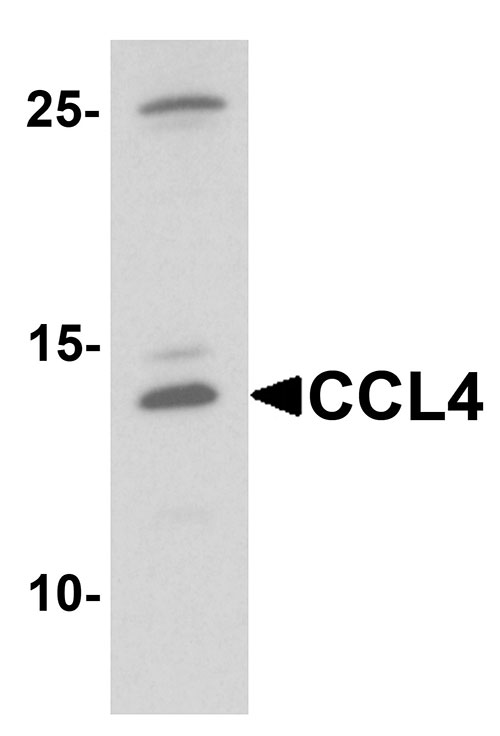CCL4 Antibody
- 产品详情
- 实验流程
- 背景知识
Application
| WB, IF, E, IHC-P |
|---|---|
| Primary Accession | P13236 |
| Other Accession | NP_002975, 4506845 |
| Reactivity | Human, Mouse, Rat |
| Host | Rabbit |
| Clonality | Polyclonal |
| Isotype | IgG |
| Calculated MW | 10212 Da |
| Concentration (mg/ml) | 1 mg/mL |
| Conjugate | Unconjugated |
| Application Notes | CCL4 antibody can be used for detection of CCL4 by Western blot at 1 - 2 µg/mL. |
| Gene ID | 388372;6351 |
|---|---|
| Other Names | C-C motif chemokine 4, G-26 T-lymphocyte-secreted protein, HC21, Lymphocyte activation gene 1 protein, LAG-1, MIP-1-beta(1-69), Macrophage inflammatory protein 1-beta, MIP-1-beta, PAT 744, Protein H400, SIS-gamma, Small-inducible cytokine A4, T-cell activation protein 2, ACT-2, MIP-1-beta(3-69), CCL4, LAG1, MIP1B, SCYA4 |
| Target/Specificity | CCL4; |
| Reconstitution & Storage | CCL4 antibody can be stored at 4℃ for three months and -20℃, stable for up to one year. |
| Precautions | CCL4 Antibody is for research use only and not for use in diagnostic or therapeutic procedures. |
| Name | CCL4 |
|---|---|
| Synonyms | LAG1, MIP1B, SCYA4 |
| Function | Monokine with inflammatory and chemokinetic properties. Binds to CCR5. One of the major HIV-suppressive factors produced by CD8+ T- cells. Recombinant MIP-1-beta induces a dose-dependent inhibition of different strains of HIV-1, HIV-2, and simian immunodeficiency virus (SIV). The processed form MIP-1-beta(3-69) retains the abilities to induce down-modulation of surface expression of the chemokine receptor CCR5 and to inhibit the CCR5-mediated entry of HIV-1 in T-cells. MIP-1- beta(3-69) is also a ligand for CCR1 and CCR2 isoform B. |
| Cellular Location | Secreted. |
For Research Use Only. Not For Use In Diagnostic Procedures.
Provided below are standard protocols that you may find useful for product applications.
BACKGROUND
CCL4 Antibody: CCL4, also known as macrophage inflammatory protein 1-beta (MIP1B), belongs to the intercrine beta (chemokine CC) family. Both CCL4 and the related protein CCL3 participate in the host response to invading bacterial, viral, parasite and fungal pathogens by regulating the trafficking and activation state of selected subgroups of inflammatory cells. While both CCL4 and CCL3 exert similar effects on monocytes, their effect on lymphocytes differ; with CCL4 selectively attracting CD4+ lymphocytes and CCL3 selectively attracting CD8+ lymphocytes. Additionally, both have been shown to be potent chemoattractants for B cells, eosinophils and dendritic cells. The processed form of CCL4 can induce down-modulation of surface expression of the chemokine receptor CCR5, thus inhibiting the CCR5-mediated entry of HIV-1 in T cells.
REFERENCES
Baixeras E, Roman-Roman S, Jitsukawa S, et al. Cloning and expression of a lymphocyte activation gene (LAG-1). Mol. Immunol. 1990; 27:1091-102.
Maurer M and von Stebut E. Macrophage inflammatory protein-1. Int. J. Biochem. Cell Biol. 2004; 36:1882-6.
Margolis LB, Glushakova S, Grivel JC, et al. Blockade of CC chemokine receptor 5 (CCR5)-tropic human immunodeficiency virus-1 replication in human lymphoid tissue by CC chemokines. J. Clin. Invest. 1998; 101:1876-80.
终于等到您。ABCEPTA(百远生物)抗体产品。
点击下方“我要评价 ”按钮提交您的反馈信息,您的反馈和评价是我们最宝贵的财富之一,
我们将在1-3个工作日内处理您的反馈信息。
如有疑问,联系:0512-88856768 tech-china@abcepta.com.























 癌症的基本特征包括细胞增殖、血管生成、迁移、凋亡逃避机制和细胞永生等。找到癌症发生过程中这些通路的关键标记物和对应的抗体用于检测至关重要。
癌症的基本特征包括细胞增殖、血管生成、迁移、凋亡逃避机制和细胞永生等。找到癌症发生过程中这些通路的关键标记物和对应的抗体用于检测至关重要。 为您推荐一个泛素化位点预测神器——泛素化分析工具,可以为您的蛋白的泛素化位点作出预测和评分。
为您推荐一个泛素化位点预测神器——泛素化分析工具,可以为您的蛋白的泛素化位点作出预测和评分。 细胞自噬受体图形绘图工具为你的蛋白的细胞受体结合位点作出预测和评分,识别结合到自噬通路中的蛋白是非常重要的,便于让我们理解自噬在正常生理、病理过程中的作用,如发育、细胞分化、神经退化性疾病、压力条件下、感染和癌症。
细胞自噬受体图形绘图工具为你的蛋白的细胞受体结合位点作出预测和评分,识别结合到自噬通路中的蛋白是非常重要的,便于让我们理解自噬在正常生理、病理过程中的作用,如发育、细胞分化、神经退化性疾病、压力条件下、感染和癌症。








